Survey results: Supporting the Named Information Officer
Results from a survey of Named Information Officers conducted by the NC3Rs and the Laboratory Animal Science Association.
On this page
Background
Under the UK Animals (Scientific Procedures) Act 1986 the Named Information Officer (NIO) is responsible for ensuring that staff working with animals have access to information specific to the species housed in their establishment and the procedures being performed [1]. According to guiding principles [2] the role of the NIO focuses on setting up and applying systems for information flow, and reviewing the local processes related to the use of animals in research. This includes information on implementing the 3Rs relevant to the research and species held at the establishment and as such the NIO is well placed to champion the 3Rs at a local level.
A recent report [3] commissioned by the NC3Rs to review how implementation of the 3Rs is supported by scientific peer review and regulatory approval processes surrounding animal research highlighted that there are significant gaps. The report highlighted that the role of the NIO needs to be better defined and resourced to help researchers and Animal Welfare Ethical Review Bodies (AWERBs) access key information on the 3Rs. These results formulate part of our evidence gathering on the support required for the NIO role.
Objectives of the study
In this survey we aimed to understand:
- How the role of the NIO works in practice.
- Additional support that might be required for NIOs to fulfil their responsibilities.
Methods
A survey was created in collaboration with the Laboratory Animal Science Association (LASA) Home Office Liaison, Training and Information Forum (HOLTIF) whose activities support NIOs. This survey has been reviewed by and approved through the Royal Veterinary College Social Science Research Ethical Review Board (ethics approval reference SR2023-0145).
A link to the survey on Microsoft Forms was distributed via the LASA HOLTIF mailing list, the NC3Rs newsletter and NC3Rs social media platforms during the period November 2023 to January 2024. There were 33 questions in total, including a mixture of multiple choice and open-text formats. A copy of the full question set can be found alongside the full study data on the Open Science Framework repository DOI 10.17605/OSF.IO/485TM.
Results
A total of 62 NIOs completed the survey, and all responses were included in the data analysis. Data described below includes all 62 responses, unless otherwise stated. Based on there being 139 licenced establishments in the UK [4] the response rate represents up to 44% of the NIO population at the time of writing (August 2024).
Of the 62 responses, 61% work at academic establishments, 16% within industry or contract-research organisations, 15% within government-funded research units, and the remainder withheld the information or work elsewhere. Using the number of project (PPL) and personal (PIL) licences as a pseudo-measure of establishment size most establishments were small with fewer than 50 PPLs and 100 PILs. Species used at the respondent's establishments were primarily rodents (52 responses) and aquatic animals (33 responses), with roughly one third of responses also using other small (e.g. rabbits) or large (e.g. pigs) mammals.
Results sections
1. Who is the NIO?
41% of respondents have an animal technology background, 32% have a research scientist background, 11% have a veterinary background, 10% have an administrative background, and 3% have a research technician background. This range of professional experience was reflected by the additional roles and responsibilities undertaken by individuals holding the NIO role. As shown in Figure 1, on average each respondent held an additional 2.74 roles on top of their NIO role, with additional responsibilities including the Home Office Liaison Contact (HOLC, 28 responses), Named Training and Competency Officer (NTCO, 19 responses), administrative role (15 responses), animal facility manager (13 responses) and Named Animal Care and Welfare Officer (NACWO, 13 responses), with many NIOs also holding a personal licence (PIL, 26 responses).
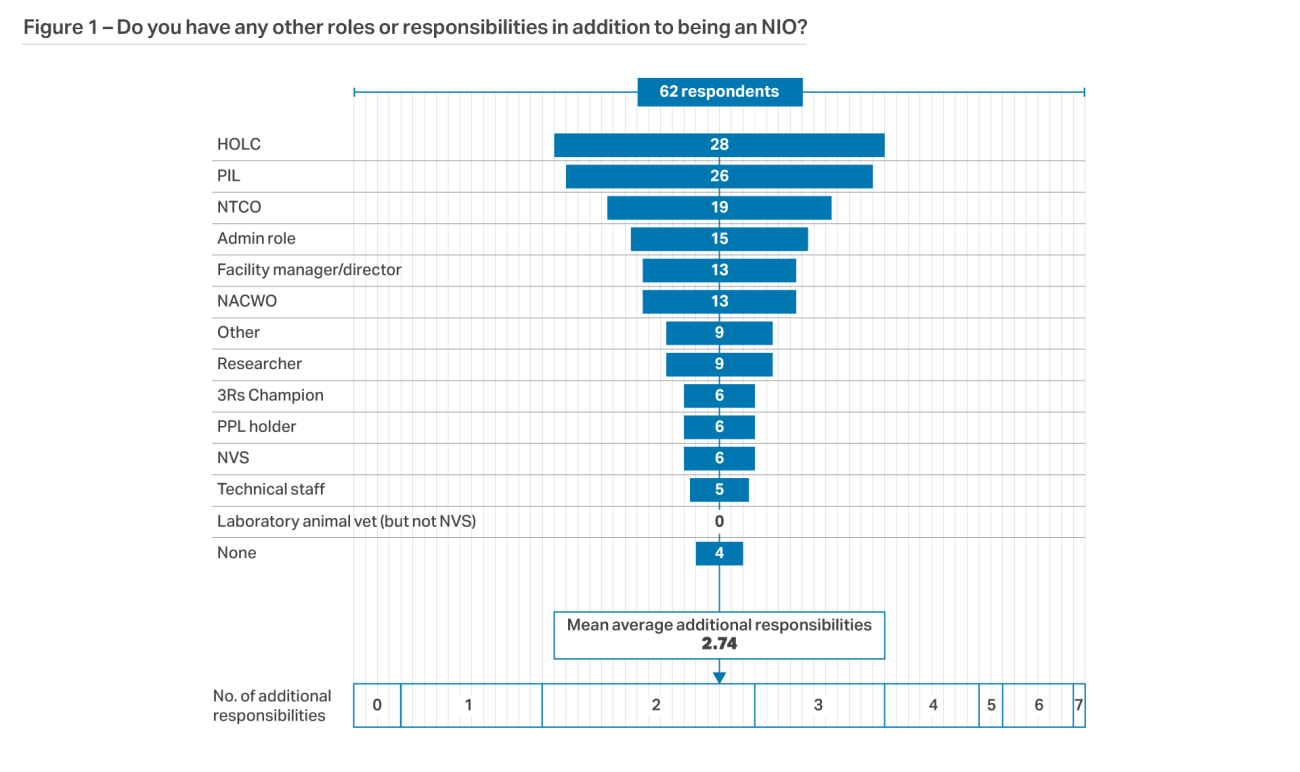
Figure 1. Additional roles or key responsibilities held by the NIO (click to enlarge). Top: values represent the number of responses per role/responsibility category, with individuals having the option to select more than one additional role. Bottom: the number of additional roles per respondent ranged between 0 (4 responses) and 7 (1 response).
2. Time allocated to the NIO role
With a tendency towards holding multiple roles (only 6% of respondents declared no roles in addition to the NIO) and/or the role being covered by more than one individual (24% of respondents shared the role with others), unsurprisingly the amount of time spent cumulatively on the NIO role was less than one day per week in most cases (68% of responses, Figure 2).
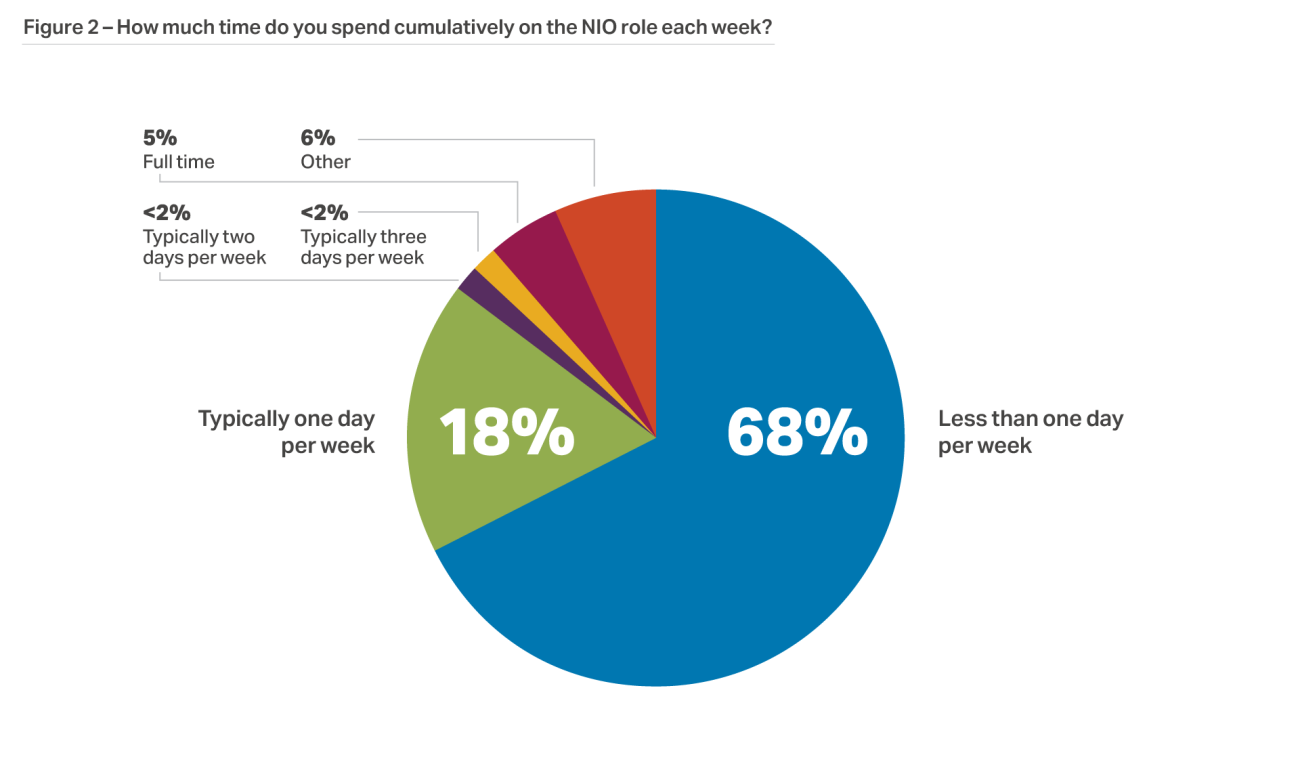
Figure 2. Typical amount of time dedicated to the NIO role on a weekly basis (click to enlarge), out of 62 responses (single choice answer).
3. Who does the NIO interact with?
Within the limited time available to them the NIOs predominantly provide information to animal users (PPL holders, PIL holders, Schedule 1 animal users*), animal facility staff (other named persons, animal technicians) and the Establishment Licence Holder (ELH), most often interacting with all these groups on a monthly basis (Figure 3). NIOs also provide information to AWERB members on average every quarter, whereas interactions with researchers not using animals were less common (50% of responses, on average yearly).
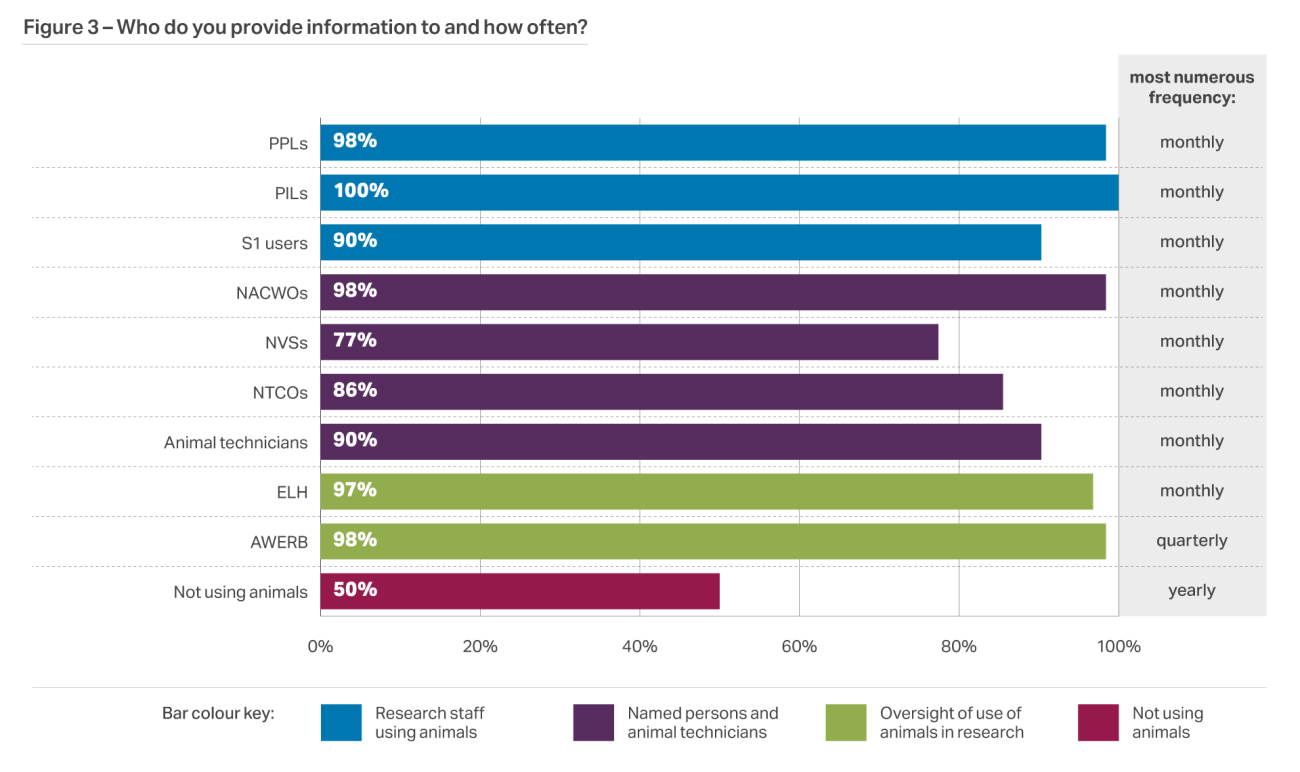
Figure 3. Groups and individuals that the NIOs interact with as part of their role with multiple selections allowed (click to enlarge). Bars represent the % of responses per category, and the frequency of interaction with each category that was selected most often (most numerous frequency) annotated in the righthand column.
*Refers to staff who have been assessed, are competent and registered to perform approved methods of humane killing listed in Schedule 1 of the ASPA, but do not hold a personal licence.
4. What information does the NIO provide?
Respondents were asked to select which topics are included in the information they provide. As shown in Figure 4 more than 88% of respondents indicated giving species-specific information on housing and husbandry, environmental enrichment and refinements (on average on a quarterly basis), information on ASPA, local rules, guidance and best practice, as well as general 3Rs advice (on average every month). Providing 3Rs advice related to experimental design and searching for alternatives to animal use were also covered by most NIOs (84% and 85%, respectively), approximately every quarter. Fewer NIOs give information on working outside of ASPA (61% of responses) or circulating opportunities for funding (58% of responses), both on average every quarter. Of note, 100% of respondents provide information on training opportunities every month, suggesting that this is a universally understood and undertaken aspect of the NIO role. Within an additional optional open-text question some responses mentioned additional information topics they cover including PPL application, training and competency, culture of care and public engagement/openness.
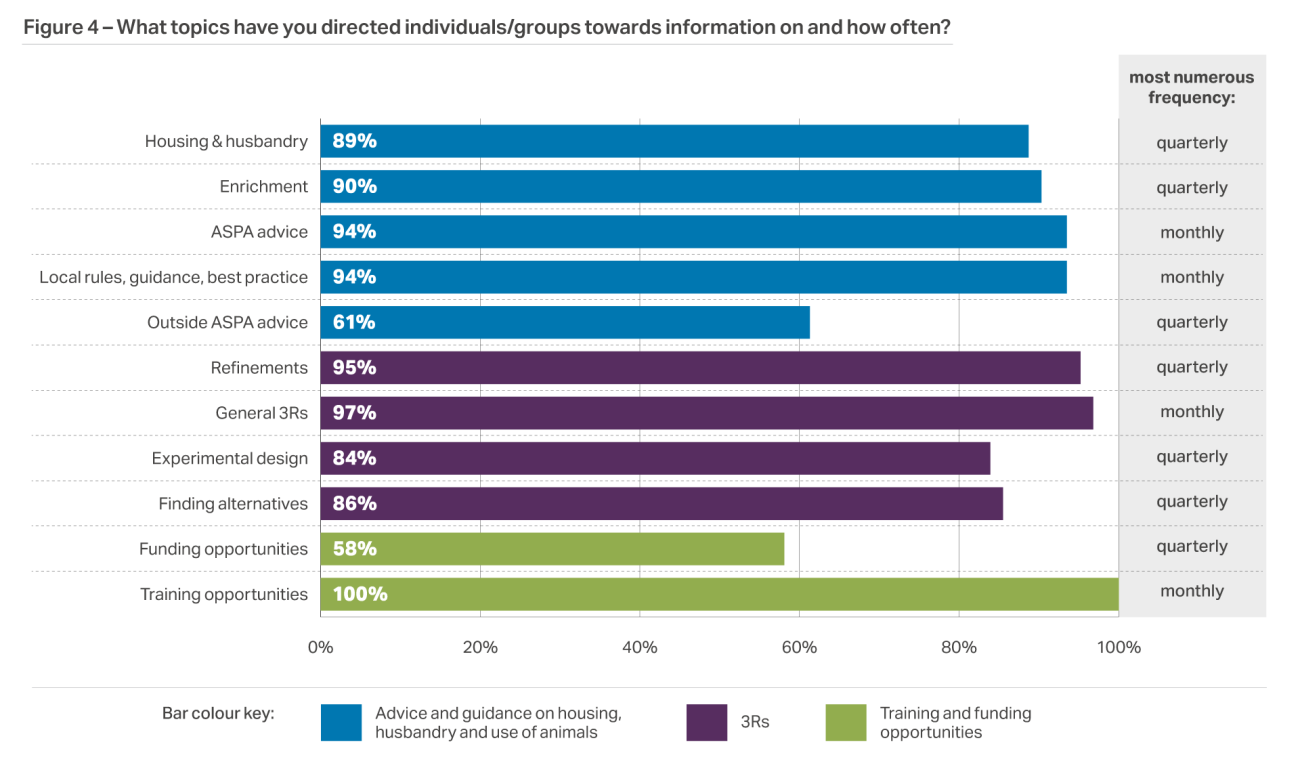
Figure 4. Topics of information handled by the NIO with multiple selections allowed (click to enlarge). Bars represent the % of responses per topic, and the frequency of handling information for each topic that was selected most often (most numerous frequency) annotated in the righthand column.
When asked what sources they use to gather information relevant to supporting those working with animals the majority consult resources provided by relevant organisations (e.g. NC3Rs 62 responses, LASA 54 responses, RSPCA 48 responses, IAT 40 responses, HOLTIF 41 responses), as well as written handbooks/guidance/codes of practice (40 responses) and scientific journals (43 responses), suggesting that the NIOs are using appropriate sources for the information they need.
5. What activities does the NIO undertake?
NIOs most frequently circulate information from other organisations (98% of responses) and respond to direct enquiries for information (95% of responses), on average every month (Figure 5). Creating information content for an intranet resource is part of the role for the majority (73% of responses), though fewer (45% of responses) prepare a dedicated newsletter. AWERB-related activities take place for most NIOs on a quarterly basis, which likely reflects the typical frequency of AWERB meetings, and 81% of respondents indicated reviewing PPLs as the NIO. Less regular and slightly less common activities for NIOs are spending time organising events related to the 3Rs (61% of responses, most frequently once a year), or facilitating topic-specific meetings (65% of responses, most frequently every quarter). Additional activities mentioned by some NIOs through optional open-text fields included attending external events, teaching or giving talks and networking or forming collaborations.
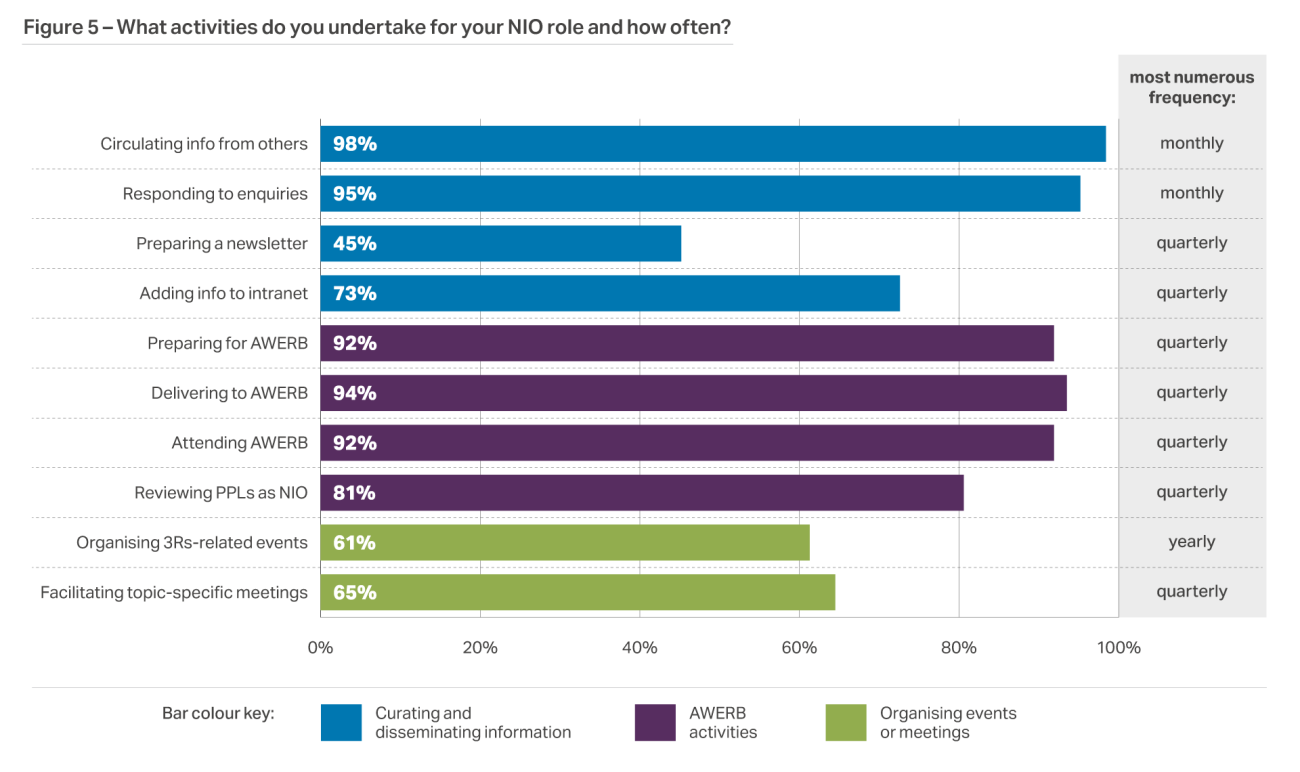
Figure 5. Activities undertaken by the NIO with multiple selections allowed (click to enlarge). Bars represent the % of responses per activity, and the frequency of undertaking each activity that was selected most often (most numerous frequency) annotated in the righthand column.
6. Understanding of the role
Fifty NIOs described their understanding of the role and gave their opinion on what the role should encompass. Thematic analysis revealed an understanding that the role includes identification or collection of information (94% of responses), dissemination of information (88% of responses), keeping abreast with research (28% of responses) and advising (18% of responses).
"I see the NIO…as a role which supports researchers and staff by advising on how to search for information they may require on the animals and procedures they are involved in. This is in addition to pushing out relevant and timely news, again related to the animals housed in the establishment."
For half of these responses there was a mismatch between their understanding of the role and their opinion of what the role should be about: the majority (80% of responses) indicating that they would like additional aspects to the role, such as a focus on acquiring 3Rs knowledge, supporting and leading on 3Rs implementation, establishing a network of NIOs and fostering collaborations.
"[The NIO should be about] Embedding the three Rs into everyday activities through improved knowledge."
In contrast the remaining 20% of responses want to change the remit so that the NIO was not solely responsible for information provision, but that this was shared across individuals (other named roles, for example).
"The NIO should be focussed on the dissemination of information and not always the locating of said information. I would consider many other named roles as contributing to the efforts of the NIO."
7. Successes and challenges of the role
When asked to highlight their successes in the role, within the 47 responses, the achievements mentioned included creating a dedicated process or event to share 3Rs advances (16 responses, e.g. local 3Rs network), being the source of information leading to changes in policy, practice or behaviour (11 responses, e.g. influencing researcher behaviour change around breeding practices), and identifying refinements which become practice (7 responses).
"[My biggest success as NIO is that] I was able to alert colleagues to a refinement which is now used routinely in many studies."
The biggest barriers to the role identified from open-text responses fell clearly into specific categories: lack of time (22 responses), awareness of the role by others (17 responses), getting access to information to share (12 responses) and understanding of the remit of the role and what they should be doing (10 responses).
"Beyond circulating newsletters from other organisations, it is hard to identify other relevant resources easily. Internally no one recognises the NIO role as a source of information."
8. Support for the NIO within the establishment
Only 40% of respondents had a budget available to support the NIO role, with this being dedicated (not shared with other roles/activities) for only 6% of respondents. Where available this budget was used for training the NIO, NIO attending meetings/events and NIO organising events.
In line with the guidance [1] NIOs are actively supported by other named persons (48 responses), the ELH (33 responses) and the AWERB (32 responses), with other support coming from administrative roles (15 responses) and 3Rs Champions (7 responses), with only 12 responses indicating an absence of support from any of the above.
Themes from optional open-text responses (42 responses) demonstrate that, where provided, this support primarily comes in the form of direct interactions (e.g. regular meetings) with the ELH (16 responses), other named persons (20 responses), the AWERB (8 responses) or interactions with other informed individuals (15 responses) such as librarians, researchers or biostatisticians. Some (13 responses) referred to other individuals/groups contributing relevant information for the NIO to pass on.
Themes from open-text answers (20 responses) to ‘What would you like your establishment to provide to help you perform your role?’:
- More dedicated time to perform the role (17 responses).
- Better recognition for the role, clearer role identity and training for the role (12 responses).
- Funding for the role (6 responses).
- Improved internal processes to connect with researchers (5 responses).
- Nothing (3 responses).
When given specific options of further support requirements, roughly one-third of respondents agreed that they would value support from their institution in the form of recognition for the role, support from other named persons and the AWERB, as well as more time and budget allocated to the role (Figure 6, green bars).
9. Support, resources and training for the NIO role from outside the establishment
89% of respondents are familiar with the guidance document [2] related to the NIO role, and more than half are aware of NIO-specific training opportunities (56% of responses), with a similar proportion (53% of responses) having undertaken specific training for role (either in house training or from external providers).
As shown in Figure 6 (purple bars), in terms of additional opportunities to expand skills and knowledge, 60% of respondents would like NIO-specific events, and 48% would be interested in receiving training on searching databases/literature for information on the use of animals in research (including advice on searching for alternatives). Whereas training in ASPA-related topics, NC3Rs resources and experimental design were considered less necessary (Figure 6, purple bars).
The most popular resource to support NIOs was a dedicated NIO newsletter (82% of responses), as well as a searchable online resource for information related to the NIO role (68% of responses), and materials for NIOs to disseminate to their community (56% of responses, Figure 6, blue bars).
Lastly, responses to an open-text question on final comments on the role and the support it needs, reflected similar themes around role identity and awareness, NIO-tailored resources, and an NIO forum/network.
"[Further support that would be most beneficial to the NIO role would be] Having a list of relevant newsletters/distribution lists/forums for individuals to sign up to. Creating a group for NIOs at different establishments to be able to communicate and share knowledge. More emphasis on the importance of the role."
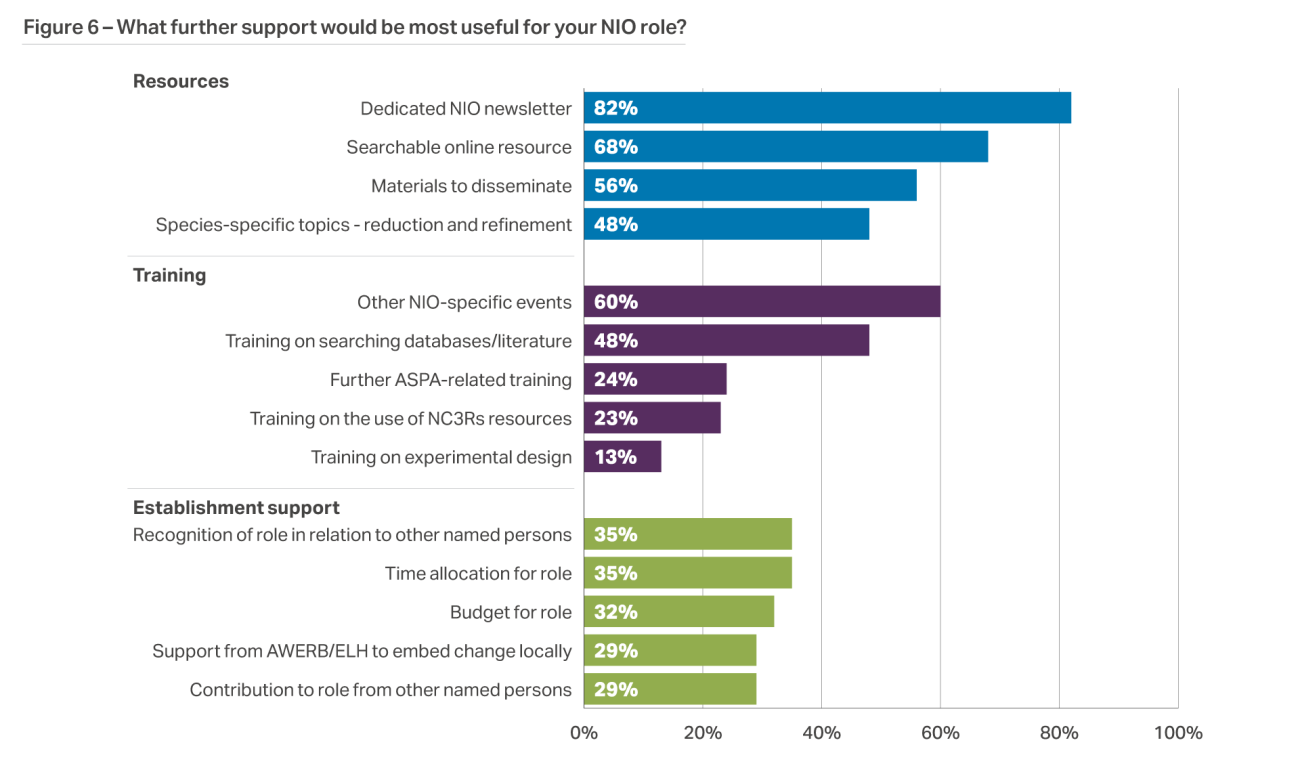
Figure 6. Additional further support needs selected from options by NIOs with multiple selections allowed (click to enlarge). Bars represent the % of responses per support option to be provided by specific resources (blue bars), training opportunities (purple bars) or the establishment (green bars).
Summary
The demographic information shows that responses to the survey represent different types of establishments, of different sizes and hosting a variety of species.
Individual NIOs come from a variety of different professional backgrounds and commonly hold more than one additional role/responsibility. It is commonplace to pair the NIO with other roles held by one individual and is likely contributing to the time-pressure acknowledged as a primary challenge by many.
Provision of information is the cornerstone purpose of the NIO role, and most NIOs regularly provide relevant information to those working with animals and the AWERB, with infrequent interaction with those not working with animals (e.g. communicating information on the use of animals at an establishment to the wider research community). Highlighting training opportunities for others is a key information topic, which also includes best practice guidance, APSA guidance and general 3Rs advice.
Aside from contributing to the AWERB functions (including PPL review), other activities of the NIO in practice are primarily responsive. The NIO circulates information that comes to them from other organisations, and they may respond to direct enquiries for information from those working with animals. The NIO may be restricted in the time they have available to carry out proactive activities, such as curation of information (e.g. creating a newsletter) or organising 3Rs-related events/meetings to share knowledge.
When asked to comment freely on the purpose and scope of their role, most responses agreed that identification, collection and dissemination of information are core functions. However, there is confusion over the identity of the role, as although half of the individuals agreed that the remit of the role should be different to current definitions, there was no consensus on whether there should be more or fewer aspects to the role.
Self-identified successes for NIOs related to sharing relevant information, changing behaviours or implementing refinements. Whereas self-identified challenges correspond to the support needs they have highlighted – a lack of time, confusion over the remit of the role, lack of awareness of the role by others and difficulties in accessing information they need.
Some NIOs have a budget associated with the role and they are broadly supported by other related roles and groups within establishments, mainly from named persons and the ELH. NIOs would like more support from their establishments in the form of time to carry out the role, support for enhancing the visibility of the role (particularly in relation to other named persons), guidance on key activities of the role, and additional funding to carry out activities.
With only half of the surveyed population having received training for the role in the past, and with all respondents regularly flagging training opportunities to others, there is notable appetite for additional training. The most popular training topic related to one of the key functions of the role outlined in the guidance [2] to ‘actively seek relevant information to disseminate’. With half of responses requesting training related to searching databases/literature for information on the use of animals in research (including the use of alternatives), suggesting some lack of confidence in this aspect of the role.
Outside of the bounds of establishments, organising regular events and opportunities specifically for the NIO was highly requested and would provide an ideal opportunity for networking and sharing experiences of activities, successes and challenges related to the role (networking was a repeated featured request in open-text responses). Respondents were also keen to receive more supportive resources including a dedicated newsletter for NIOs, a searchable online resource at their disposal and materials to disseminate.
Conclusion
In conclusion, the survey results indicate that the individual NIO holds more than one role or responsibility, is time-poor, with variable understanding of the remit of their role. The NIO has some support from named persons and the ELH, but awareness from others on the scope and activities of the role is low. NIOs need further support from:
- Their establishments to recognise the importance and awareness of the role in facilitating best practice and promoting the 3Rs within the local animal research community.
- External bodies (e.g. the Animals in Science Regulation Unit, LASA) to provide clearer direction on the extent of responsibilities associated with the role.
- Additional resources and training, to increase their efficiency in accessing and disseminating information.
- NIO-specific networking opportunities that bring the community together.
To begin to address some of the needs NIOs identified in the survey, the NC3Rs and the LASA HOLTIF section hosted an in-person workshop for the NIO community in September 2024. Recordings of the talks along with short summaries are available on the NC3Rs website: Staying informed on advances in the 3Rs and animal research.
A summary of the workshop discussion can be found in the Workshop report: Supporting the Named Information Officer.
References
- Home Office (2020). Guidance on the Operation of the Animals (Scientific Procedures) Act 1986.
- LASA/LAVA/IAT (2023). Guiding Principles for Establishment Licence Holders/Named Persons Responsible for Compliance, Named Training and Competency Officers, Named Information Officers and Home Office Liaison Contacts working under the Animals (Scientific Procedures) Act 1986.
- Rawle F (2023). The role of review and regulatory approvals processes for animal research in supporting implementation of the 3Rs.
- Home Office (2023). Annual Statistics of Scientific Procedures on Living Animals, Great Britain: 2022.
Find out more about our project to better understand how the NIO role is supported in the UK and identify opportunities for further support.

